Pressure sensors with open flush diaphragms, specifically designed for reliable measurement in high viscosity media like plastics, pulp, bitumen, sewage, paint & adhesives. Avoid clogging issues.
Measuring pressure in challenging, highly viscous media like plastics, paper pulp, bitumen, sewage, paints, or adhesives requires specialized instrumentation. High viscosity fluid pressure sensors feature an open, flush diaphragm design that eliminates cavities prone to clogging, ensuring direct contact with the medium for accurate readings and allowing easy cleaning of residue build-up, critical for maintaining performance in demanding industrial applications.
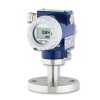 XMPi Process Plant Gauge and Absolute Pressure Transmitter - Process transmitter for measuring vacuum, steam, food, pharmaceutical, oil, gas and other pressure readings necessary for the monitoring and control of bulk production processes.
XMPi Process Plant Gauge and Absolute Pressure Transmitter - Process transmitter for measuring vacuum, steam, food, pharmaceutical, oil, gas and other pressure readings necessary for the monitoring and control of bulk production processes.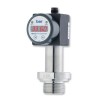 DS200P Sanitary Low Range Pressure Gauge, Switch and Sensor - All in one electronic switch, gauge and sensor designed specifically for use in the food, drink and biomedical industry for measuring process pressures.
DS200P Sanitary Low Range Pressure Gauge, Switch and Sensor - All in one electronic switch, gauge and sensor designed specifically for use in the food, drink and biomedical industry for measuring process pressures.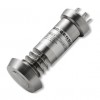 DMP331P Hygienic Flush Pressure Transmitter - Sanitary pressure sensor wth exposed diaphragm with no crevices for high temperatures up to 300 Degrees Celsius in ranges from 100mb up to 40 bar gauge or absolute
DMP331P Hygienic Flush Pressure Transmitter - Sanitary pressure sensor wth exposed diaphragm with no crevices for high temperatures up to 300 Degrees Celsius in ranges from 100mb up to 40 bar gauge or absolute LMK387 Cleanable Sewage and Sludge Pressure/Level Sensor - Rugged and easily cleanable pressure/level sensor for use with waste water sewage or sludge.
LMK387 Cleanable Sewage and Sludge Pressure/Level Sensor - Rugged and easily cleanable pressure/level sensor for use with waste water sewage or sludge. TPFADA Flush Diaphragm Pressure Transmitter - Flush diaphragm pressure transmitter for high viscosity media in food processing and plastic injection moulding applications.
TPFADA Flush Diaphragm Pressure Transmitter - Flush diaphragm pressure transmitter for high viscosity media in food processing and plastic injection moulding applications.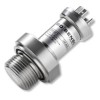 DMK331P Flush Diaphragm Pressure Sensor - Screw-in pressure transmitter with flush stainless steel 316L diaphragm for measuring pressures of fluids with very high viscosity from 900 up to 6000 psi
DMK331P Flush Diaphragm Pressure Sensor - Screw-in pressure transmitter with flush stainless steel 316L diaphragm for measuring pressures of fluids with very high viscosity from 900 up to 6000 psi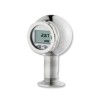 x|act i Rangeable Flush Pressure Transmitter with LCD Readout - Rangeable Pressure Transmitter with a hygienic all stainless steel construction with LCD digital readout display and optional HART communications.
x|act i Rangeable Flush Pressure Transmitter with LCD Readout - Rangeable Pressure Transmitter with a hygienic all stainless steel construction with LCD digital readout display and optional HART communications. LMK 487 Submersible Ballast Tank and Draught Level Pressure Transmitter - A 22mm diameter titanium body seawater depth and level probe with a 4-20mA output with Lloyds and DNV-GL ship approval, for monitoring the quantity of ballast or the draft of a ship’s hull.
LMK 487 Submersible Ballast Tank and Draught Level Pressure Transmitter - A 22mm diameter titanium body seawater depth and level probe with a 4-20mA output with Lloyds and DNV-GL ship approval, for monitoring the quantity of ballast or the draft of a ship’s hull. DCT531P RS485 Modbus RTU Flush Pressure Sensor - RS485 Modbus RTU serial interface pressure sensor with exposed all welded stainless steel 316L flush diaphragm in ranges from 100mb up to 40 bar gauge or absolute.
DCT531P RS485 Modbus RTU Flush Pressure Sensor - RS485 Modbus RTU serial interface pressure sensor with exposed all welded stainless steel 316L flush diaphragm in ranges from 100mb up to 40 bar gauge or absolute. TPF Flush Diaphragm Strain Gauge Pressure Sensor - Flush diaphragm piezo-resistive pressure sensor for food processing and plastic injection moulding applications with a millivolt output signal in pressure ranges from 10 up to 1000 barg.
TPF Flush Diaphragm Strain Gauge Pressure Sensor - Flush diaphragm piezo-resistive pressure sensor for food processing and plastic injection moulding applications with a millivolt output signal in pressure ranges from 10 up to 1000 barg.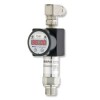 DS201P High Range Flush Pressure Gauge, Switch and Sensor - High pressure sensor, electronic switch and digital gauge with an all welded stainless steel flush diaphragm for high viscosity liquids.
DS201P High Range Flush Pressure Gauge, Switch and Sensor - High pressure sensor, electronic switch and digital gauge with an all welded stainless steel flush diaphragm for high viscosity liquids.
Find out more about High Viscosity Fluid Pressure Sensors to determine which product options and capabilities will best meet your application requirements.
Pressure measurement in applications involving highly viscous fluids presents unique challenges that standard sensor designs often fail to meet. Media such as molten plastics, dense paper pulp, hot bitumen, untreated sewage, industrial paints, and high-solid adhesives can easily clog the small ports or cavities found in conventional pressure sensor process connections. This clogging not only leads to inaccurate or completely lost readings but can also necessitate frequent and costly downtime for cleaning or replacement.
To overcome these issues, pressure sensors specifically designed for high viscosity fluids utilize an open or flush diaphragm construction. In this design, the sensing diaphragm is positioned at the very front of the sensor, directly exposed to the process media without any intervening cavities or narrow channels. This eliminates dead spaces where thick or particle-laden fluids can accumulate, solidify, or otherwise obstruct the pressure path.
The primary advantage of the flush diaphragm design is its inherent resistance to clogging when interacting with viscous, sticky, or slurry-like substances. The smooth, continuous surface allows the medium to flow across it, ensuring consistent contact for accurate pressure transmission. This design is crucial in applications like monitoring melt pressure in plastics extrusion machines, controlling headbox pressure in paper manufacturing where pulp fibres are present, or measuring pressure in bitumen handling systems for road surfacing.
Furthermore, the accessibility of the sensing surface is a significant benefit for maintenance. Should any residue accumulate on the diaphragm over time, as can happen with materials like curing paints, setting adhesives, or drying sludge, the exposed nature of the flush diaphragm allows for easy cleaning. Maintenance personnel can often wipe or flush the diaphragm surface clean without needing to fully remove the sensor or resort to complex cleaning procedures, thereby minimizing process interruption and maintaining measurement accuracy.
Selecting the appropriate diaphragm material is also critical, considering the potential chemical aggressiveness or abrasive nature of the viscous media. Options often include robust stainless steel grades or specialized alloys like Hastelloy C276, chosen for compatibility with specific substances ranging from corrosive chemical slurries to abrasive food products or wastewater sludge. The reliability of pressure readings in applications involving thick or potentially solidifying media hinges on this specialized flush diaphragm construction, preventing blockages and facilitating essential cleaning routines.
